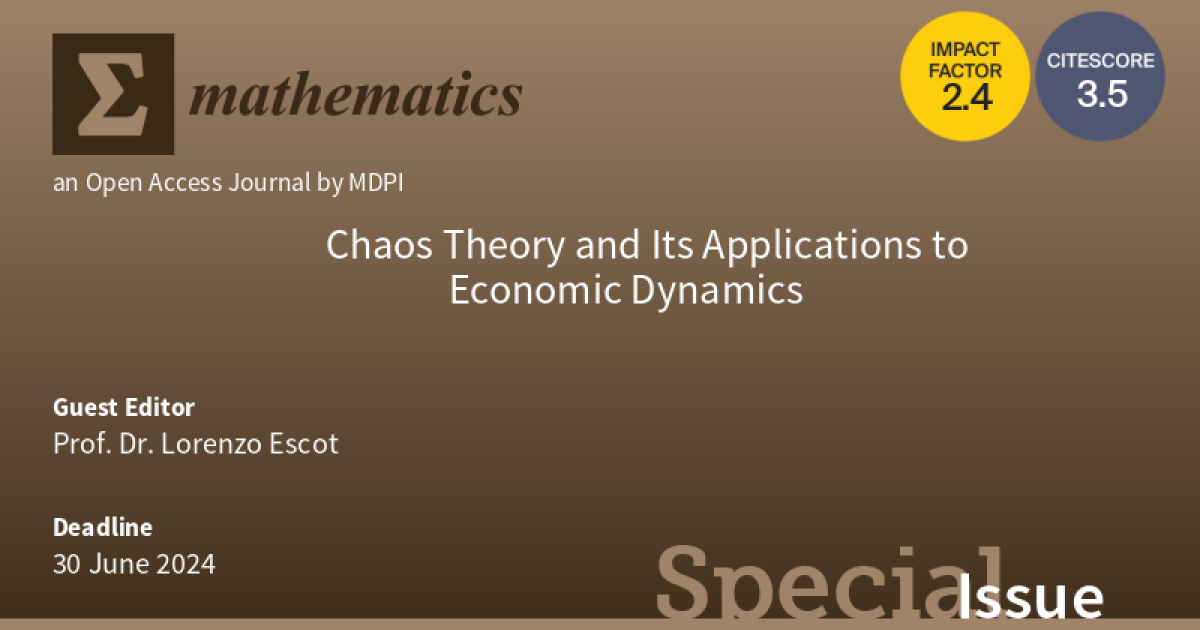Chaos Theory and Its Applications to Economic Dynamics
A special issue of Mathematics (ISSN 2227-7390). This special issue belongs to the section "Dynamical Systems".
Deadline for manuscript submissions: 30 June 2024 | Viewed by 10131

Special Issue Editor
Interests: deterministic chaos mathematics and its applications to economic dynamics; data mining in financial risk management and risk scoring; applied econometrics; data analysis in social studies, economics and finance; spatial econometrics
Special Issue Information
Dear Colleagues,
Chaos theory refers to the behaviour of certain deterministic nonlinear dynamical systems whose solutions, although globally stable, are locally unstable. These chaotic systems describe aperiodic, irregular, apparently random and erratic trajectories, i.e., deterministic complex dynamics.
Most economic time series exhibit this type of erratic and irregular cyclical behaviour. The way in which traditionally economists have dealt with these complex dynamics has been through linear deterministic models to which purely random shocks are added to explain irregularity. Chaos theory provides a new possibility to explain the irregularity and aperiodicity of economic phenomena without the need to appeal to purely stochastic behaviour.
In this Special Issue, we aim to present the recent developments in the Applications of Chaos Theory to Economics Dynamics in two main areas. On the one hand, in the development of theoretical models that, based on a rigorous economic foundation, allow the emergence of chaotic solutions.
The second main area of application is the empirical or statistical analysis of chaotic economic and financial time series. More specifically, the application of tools to detect chaotic behavior from time series, that is, to differentiate chaotic motions from purely random fluctuations even when the economic systems that generates the time series are unknown.
This Special Issue will accept high-quality papers containing original research results and review articles of exceptional merit in the following fields.
- Chaos models in economics (business cycle, economic growth, income distribution, economic networks, imperfect competition markets)
- Chaos theory in financial markets
- Detection of Chaos in economic and financial time series (application of Lyapunov exponents, Fractal Dimension, test for nonlinearities, …)
- Predictability and Chaos control in Economics
Prof. Dr. Lorenzo Escot
Guest Editor
Manuscript Submission Information
Manuscripts should be submitted online at www.mdpi.com by registering and logging in to this website. Once you are registered, click here to go to the submission form. Manuscripts can be submitted until the deadline. All submissions that pass pre-check are peer-reviewed. Accepted papers will be published continuously in the journal (as soon as accepted) and will be listed together on the special issue website. Research articles, review articles as well as short communications are invited. For planned papers, a title and short abstract (about 100 words) can be sent to the Editorial Office for announcement on this website.
Submitted manuscripts should not have been published previously, nor be under consideration for publication elsewhere (except conference proceedings papers). All manuscripts are thoroughly refereed through a single-blind peer-review process. A guide for authors and other relevant information for submission of manuscripts is available on the Instructions for Authors page. Mathematics is an international peer-reviewed open access semimonthly journal published by MDPI.
Please visit the Instructions for Authors page before submitting a manuscript. The Article Processing Charge (APC) for publication in this open access journal is 2600 CHF (Swiss Francs). Submitted papers should be well formatted and use good English. Authors may use MDPI's English editing service prior to publication or during author revisions.
Keywords
- chaos theory in economics
- chaos theory in financial markets
- nonlinear economic dynamics
- complex economics dynamics
- detection of chaotic behaviour in economics and financial markets
- Lyapunov exponents
- fractal dimension
- nonlinear economic and financial time series analysis
- chaos control in economics
- forecasting economic and financial time series





